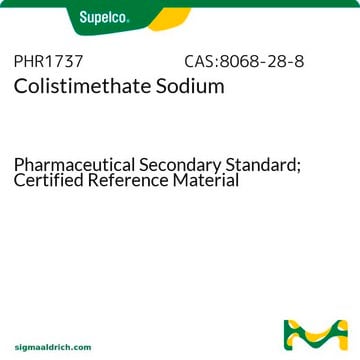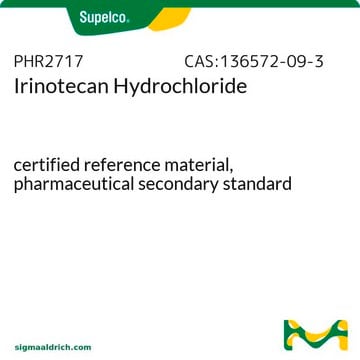1481306
USP
Oxaliplatin System Suitability
United States Pharmacopeia (USP) Reference Standard
Synonym(s):
[SP-4-2-(1R-trans)]-Dichloro(1,2-cyclohexanediamine-N,N′)platinum, [SP-4-2-(1R-trans)]-(1,2-Cyclohexanediamine-N,N′)dichloridoplatinum(II)
About This Item
Recommended Products
grade
pharmaceutical primary standard
API family
oxaliplatin
manufacturer/tradename
USP
application(s)
pharmaceutical (small molecule)
format
neat
storage temp.
2-8°C
InChI
1S/C6H12N2.2ClH.Pt/c7-5-3-1-2-4-6(5)8;;;/h5-8H,1-4H2;2*1H;/q-2;;;+4/p-2
InChI key
UUERTZXRKZEANK-UHFFFAOYSA-L
General description
For further information and support please go to the website of the issuing Pharmacopoeia.
Application
- Innovative Lung Drug Delivery: Oxaliplatin system suitability is crucial in the development of inhalable porous particles for efficient lung drug delivery systems. This application significantly improves therapeutic outcomes in diseases such as tuberculosis by ensuring optimal particle size and drug formulation consistency for deep lung penetration (Campos Pacheco et al., 2024).
- Pulmonary Health Monitoring: Respirable cristobalite exposure effects are critically assessed in workplace settings using oxaliplatin as a reference standard in silica-induced pulmonary inflammation studies. This research is vital for occupational health safety, enhancing our understanding of chronic respiratory conditions caused by inhalable mineral particles (Heine et al., 2024).
- Respiratory Disease Research: Oxaliplatin system suitability standards are employed in environmental health studies to evaluate the impact of respirable dust on lung health. Such standards ensure the accuracy and reliability of data crucial for developing interventions aimed at reducing the incidence of respiratory diseases in industrial settings (Beard et al., 2024).
- Environmental Safety Analysis: High-purity oxaliplatin is used in analytical methods to differentiate asbestos from cristobalite, aiding in environmental safety assessments and regulatory compliance. This application ensures the protection of public health by identifying hazardous materials in building and construction environments (Lee et al., 2024).
- Occupational Health Standard Development: Oxaliplatin standards are integral in comparative studies of occupational exposure limits internationally, particularly concerning coal dust which includes respirable cristobalite. Such research informs policy-making and helps establish safer working conditions across different industries (Li and Zhu, 2024).
Analysis Note
Other Notes
related product
Signal Word
Danger
Hazard Statements
Precautionary Statements
Hazard Classifications
Carc. 2 - Eye Irrit. 2 - Muta. 1B - Repr. 1B - STOT RE 1
Target Organs
Nervous system
Storage Class Code
6.1C - Combustible acute toxic Cat.3 / toxic compounds or compounds which causing chronic effects
WGK
WGK 3
Flash Point(F)
Not applicable
Flash Point(C)
Not applicable
Certificates of Analysis (COA)
Search for Certificates of Analysis (COA) by entering the products Lot/Batch Number. Lot and Batch Numbers can be found on a product’s label following the words ‘Lot’ or ‘Batch’.
Already Own This Product?
Find documentation for the products that you have recently purchased in the Document Library.
Our team of scientists has experience in all areas of research including Life Science, Material Science, Chemical Synthesis, Chromatography, Analytical and many others.
Contact Technical Service









